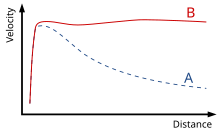Wikipedia:Reference desk/Archives/Science/2018 April 24
| Science desk | ||
|---|---|---|
| < April 23 | << Mar | April | May >> | April 25 > |
| Welcome to the Wikipedia Science Reference Desk Archives |
|---|
| The page you are currently viewing is an archive page. While you can leave answers for any questions shown below, please ask new questions on one of the current reference desk pages. |
April 24
[edit]Galaxy Rotation Curves
[edit]
There was a thread here in the Science Desk recently about the dark matter. It spurred my interest and I've come upon this video. It depicts two galaxies: the one on the left is a modern galaxy and the one on the right is from a distant universe, perhaps 10 billion years ago. I really have a bunch of questions about the phenomenon. Click on the triangle and the galaxies start rotating. One can see that the contemporary galaxy rotates much faster than the distant one. Where did it get this angular momentum? I understand it is not necessarily the same galaxy, but hopefully a typical galaxy as it is.
Look at the left galaxy carefully. There is something strange about it. The spiral arms start at the same angular position, in case of the "right" arm at 12 o'clock position as we see it. It should rotate, and it does but there is a complicated movements of stars inside the galaxy ecliptic. When this "right" arm moves slightly, new stars form the missing portion and after a short time the external arm still starts at 12 o'clock. The same is true for the other arm.
Where do those stars come from? It seems they are thrown by a centrifugal force from the outskirts of the galactic bulge, then they drift to the periphery to be used for reconstitution of both arms! How come other stars in the bulge do not follow them?
The stars that travel, they are eventually brought back to the galactic bulge, so they end up again closer the the galaxy center. What is the force that moves them there? Can you imagine our Sun ending up near the Sagittarius A? According to the video, the galactic arms work as two brooms sweeping the stars from distant regions of the galaxy and bringing them to the bulge.
I wonder how realistic this video is? The curve on the top is the plot of rotation speed of the stars measured experimentally in a typical galaxy which is supposed to explain the videos, but does it?
Also if there is so much dark matter right beyond the circumference of the galaxy, the stars should gravitate to it. Instead they are repulsed, if you look carefully at the stars movement in the video.
Thanks AboutFace 22 (talk) 21:27, 24 April 2018 (UTC)
- I can't specifically answer your questions on the simulations, but would point out that galactic arms aren't objects, they're density waves, and will not behave as a consistent body of the same stars. "centrifugal force" would not apply in the sense you're describing to a body of individual stars orbiting around a center of mass. Acroterion (talk) 00:20, 25 April 2018 (UTC)
- Yes, see Crash Course Astronomy. --47.146.63.87 (talk) 07:47, 25 April 2018 (UTC)
- The picture is misleading in that it implies the galaxy on the right would become like the one one the left when the dark matter clumped more round it. In fact what would happen is that it would become considerably smaller. There is no addition of angular momentum - the stars would circle closer to the center of the galaxy. Dmcq (talk) 10:31, 25 April 2018 (UTC)
@Acroterion, You are in error. Any object moving in a circle or over an arc of any curvature will experience a centrifugal force. AboutFace 22 (talk) 19:28, 25 April 2018 (UTC)
it is so that we have different movement for stars round galaxy center . I prefer to discuss this in other where , but for introduction >I say that there are three facts and in my theoretical resultants . I had said 1. the time and space distance of velocity measurement is relativistic . 2. the main un deniable fact which I named galactic rotation
3. we have other dynamic in galaxy sized case .different from existing mined --Akbarmohammadzade (talk) 07:30, 30 April 2018 (UTC)
